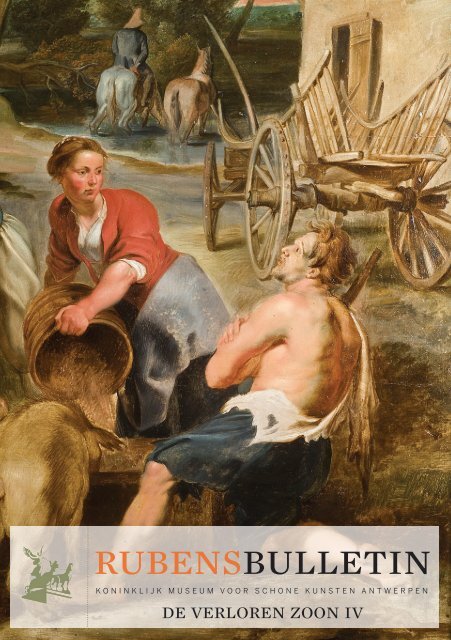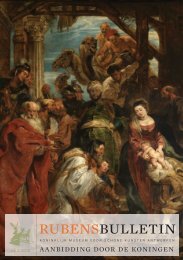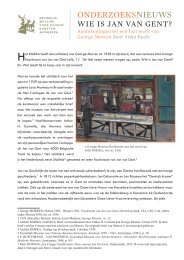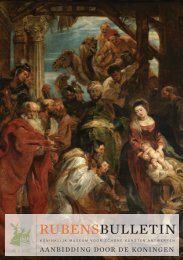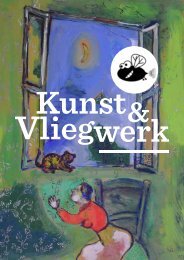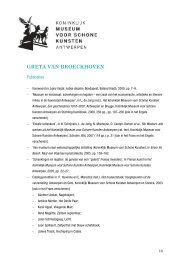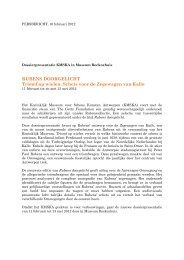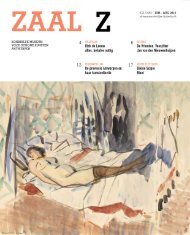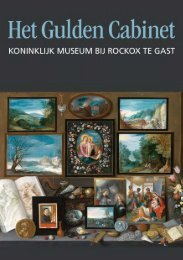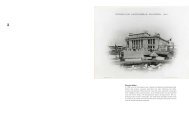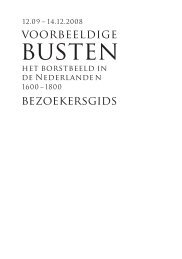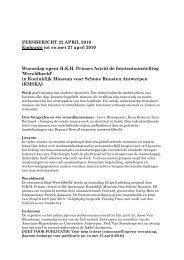III. Painting Technique and Restoration (PDF, 5,21 MB) - Koninklijk ...
III. Painting Technique and Restoration (PDF, 5,21 MB) - Koninklijk ...
III. Painting Technique and Restoration (PDF, 5,21 MB) - Koninklijk ...
Create successful ePaper yourself
Turn your PDF publications into a flip-book with our unique Google optimized e-Paper software.
BULLETIN<br />
rubensbulletin<br />
KONINKLIJK MUSEUM VOOR SCHONE KUNSTEN ANTWERPEN<br />
de verloren zoon iv
BULLETIN<br />
BULLETIN<br />
THE PRODIGAL SON<br />
BY PETER PAUL RUBENS<br />
<strong>III</strong>. PAINTING TECHNIQUE AND RESTORATION<br />
Susan Farnell<br />
with additional comments by Nico Van Hout<br />
The recent restoration<br />
The Prodigal Son has just been restored. It was in good condition but the<br />
restoration was necessary because it was becoming increasingly difficult<br />
to see the painting through the layers of thick <strong>and</strong> discoloured varnish.<br />
Rubens must have intended the dramatic perspective of the view through<br />
the barn to give an added sense of depth to this composition while also<br />
experimenting with the effects of daylight <strong>and</strong> c<strong>and</strong>lelight. The loss of<br />
transparency <strong>and</strong> the browning of the varnish had not only dulled the<br />
colours but had also greatly reduced the sense of space <strong>and</strong> light within<br />
the painting. The restoration has involved the gradual removal of the layers<br />
of varnish <strong>and</strong> over-painting from what is often a remarkably thin paint<br />
layer. There has been wide use made of brown glazes in this painting. In<br />
many areas the paint is applied so thinly that the underlying light ground<br />
can be seen through the brush-strokes. Fortunately the general condition<br />
of the paint layer was good with few important losses. The restoration has<br />
meant that we can now see Rubens’ painting clearly; we can appreciate<br />
the different sources of light, the free h<strong>and</strong>ling of the paint <strong>and</strong> the<br />
extraordinary sense of depth within the composition.<br />
Technical study<br />
The restoration process provides an ideal occasion to observe a painting at<br />
close quarters <strong>and</strong> at the same time the opportunity to carry out technical<br />
<strong>and</strong> scientific documentation. 1<br />
The advantage of studying the technique of a recently restored painting<br />
is being able to see the paint layer rather than trying to imagine it, hidden<br />
under layers of dark <strong>and</strong> obscuring varnish. In the case of The Prodigal<br />
Son, the technique proved to be a great deal more spontaneous <strong>and</strong> the<br />
execution more rapid than it was thought to be prior to restoration. 2<br />
<strong>Technique</strong><br />
a. The support<br />
The Prodigal Son was painted on a well-constructed oak panel which<br />
measures 109.75 x 158.2 cm. It is composed of 5 horizontal planks which<br />
are butt-joined (ill. 1).<br />
1. 22 - 23 cm<br />
2. 22 cm<br />
3. 20.75 cm<br />
4. 24.75 cm<br />
5. 20.50 cm<br />
Ill.1 The dimensions <strong>and</strong> position of the planks, recto side.<br />
All the planks are quarter-sawn; the fourth plank is partly false quartersawn,<br />
where the medullary rays cross the annual rings diagonally. The<br />
wood came from the Baltic region <strong>and</strong> planks 2, 3 <strong>and</strong> 5 are from the same<br />
tree. Dendrochronology has been able to give an earliest felling date of<br />
1613 for the fourth plank, giving the earliest possible creation date as 1615.<br />
However allowing a 15-year average for sap wood rings, the more probable<br />
date would be later, from 16<strong>21</strong> onwards. 3
BULLETIN<br />
BULLETIN<br />
Information about the construction<br />
of the panel is limited by the<br />
presence of a cradle (ill. 2) <strong>and</strong> a<br />
double layer of lead white paint<br />
applied between the elements of<br />
the cradle in1895. 4<br />
The panel must have been planeddown<br />
in order to attach the cradle.<br />
Under the vertical battens, we<br />
can see that areas of the panel<br />
were built-up by pieces of oak of<br />
approximately 4<br />
x 12 cm, glued side by side, presumably to<br />
create a level surface for attaching the fixed<br />
horizontal elements of the cradle (ill. 3). 5<br />
Ill.2 The cradle on the reverse of the panel<br />
The panel has been reduced in size on all<br />
four sides but the presence of the vertical<br />
prepared but unpainted edges on the recto<br />
side, tells us that the amount may be slight as<br />
the painting proper is intact.<br />
The “unpainted edges” or margins correspond<br />
approximately to a rebate of between 3 -7<br />
mm, cut at a right-angle into the vertical<br />
edges on the reverse of the panel (ill. 4). This appears<br />
to be part of the original construction. We had thought<br />
that the rebates were related to the framing but it now<br />
seems probable that they were made to accommodate<br />
temporary grooved battens, or ‘channel edge supports’<br />
that were slid onto the end-grain edges of panels to<br />
prevent warping. 6 A similar rebate can be found on the<br />
reverse of the panel of “Christ <strong>and</strong> the Woman taken in<br />
Adultery” by Rubens in the Musée Royal des Beaux-<br />
Arts, Brussels. 7 The ‘unpainted’ edges of The Prodigal<br />
Son have a ground layer (unlike the Brussels panel).<br />
Ill.3 Detail of where a vertical batten of the<br />
cradle has been removed to show that the<br />
back of the panel had been built up before the<br />
cradle was attached.<br />
It seems that ‘channel edge supports’ may have been put on in the studio,<br />
during the painting process, presumably when the panel began to warp.<br />
This could explain why some paint can be found on the unpainted edge<br />
but a distinct margin, or limit to the paint layer, was made once the battens<br />
were in place.<br />
b. The frame<br />
We have no information about the original frame. The frame in which that<br />
The Prodigal Son is currently shown is of English origin, dating from the<br />
19 th century.<br />
c. The ground<br />
The panel was prepared with what looks like the traditional chalk glue<br />
ground (ill. 5). It is off-white, thinly applied <strong>and</strong> is smooth <strong>and</strong> hard. Very<br />
few samples were taken <strong>and</strong> in the cross-section (ill. 8) the ground appears<br />
to be absent.<br />
The ground continues to the edge of<br />
the panel where the sharpness of the<br />
outline confirms that the panel has<br />
been trimmed. The “unpainted” but<br />
prepared edges of the vertical sides of<br />
the panel were obviously intended to<br />
be covered later by the frame.<br />
No isolation layer was visible. Because<br />
much of the paint layer was thinly<br />
applied, the white ground influences<br />
Ill.5 Detail of the “unpainted” edge or margin.<br />
The white ground can be seen where the frame has<br />
rubbed away the overlying paint layers<br />
the final painting by allowing light to<br />
reflect through even the darker areas,<br />
adding luminosity <strong>and</strong> transparency.<br />
Ill.4 Detail of rebate along the vertical edge
BULLETIN<br />
BULLETIN<br />
d. The imprimatura<br />
A pale grey stripey imprimatura is present but not easily detected. Stripey<br />
imprimatura is characteristic of Rubens panel paintings but it is most<br />
commonly seen in his sketches on panel, such as the recently restored<br />
Triumphal Chariot of Kalloo (KMSKA, inv. no 318),<br />
where the imprimatura is ochre rather than grey.<br />
It is often less apparent in his finished paintings, as<br />
is the case here. It can be seen, however, in the gap<br />
between the painted contours of the wooden post<br />
<strong>and</strong> the sky <strong>and</strong> through the transparent brown<br />
paint of the post (ill. 6). The imprimatura can be<br />
seen more clearly with infrared photography (ill.<br />
7) where it appears to have<br />
been roughly applied with<br />
a wide bristle brush in<br />
horizontal <strong>and</strong> diagonal<br />
directions (2.), changing<br />
to a vertical direction<br />
along the vertical edges.<br />
Ill.6 The grey stripey imprimatura<br />
can be seen in the gap in the paint<br />
between the post <strong>and</strong> the sky.<br />
Rubbed away the overlying paint<br />
layers.<br />
The stripey imprimatura may have acted as an<br />
isolation layer preventing the oil of the paint layer<br />
from sinking into the porous white ground. It<br />
was also a device to give a tonality to the ground<br />
without losing its luminosity.<br />
Ill. 7 The grey stripey imprimatura<br />
is visible under the transparent paint<br />
layer of the tree <strong>and</strong> the wooden post.<br />
e. The underdrawing<br />
No underdrawing was visible or detected by infra-red photography. It is,<br />
in any case, unusual to find underdrawing in Rubens’s finished paintings,<br />
although more common in his sketches. An example, however, can be found<br />
in The Farm at Laeken, (London, The Royal Collection), where “lines of<br />
underdrawing are visible in the arm <strong>and</strong> face of the st<strong>and</strong>ing woman in the<br />
centre” 8<br />
f. The paint layer<br />
Pigments<br />
Analysis: a number of inorganic pigments have been identified by using<br />
PXRF, a non-destructive method of analysis. 9 Organic pigments frequently<br />
used by Rubens, such as red <strong>and</strong> yellow organic glazes, indigo, Cassel earth<br />
<strong>and</strong> bitumen, cannot be identified by this method of analysis.<br />
The following pigments were identified: white lead was identified in the<br />
29 places that were analysed; sienna or possibly umber in the browns with<br />
occasional traces of vermilion; vermilion probably in combination with red<br />
earth for the reds; in the yellow highlights of the hay, lead-tin yellow with<br />
probably a yellow earth. The greens were composed of a mixture of yellow,<br />
probably lead tin yellow <strong>and</strong> a copper containing pigment, such as azurite,<br />
or blue or green verditer. The blues used for clothing contained copper<br />
indicating the use of azurite or blue verditer. However the blue for the sky<br />
could be identified as either indigo or ultramarine / lapis lazuli. Very few<br />
samples were taken from the paint layer. Two samples were taken from<br />
the grey paint on the margin of the left edge. This was to identify the large<br />
white grains that occur throughout the paint layer but predominantly in<br />
the dark area of the roof, on the left side of the picture. Another sample was<br />
taken in the sky to identify the blue pigment that could not be determined<br />
by PXRF.<br />
The ubiquitous white granular pigment was identified as lead white. The<br />
sample taken to analyse the blue pigment in the sky can be seen in crosssection<br />
(ill.8) where ultramarine/<br />
lapis lazuli was identified. The<br />
under-lying grey layer contains<br />
chalk <strong>and</strong> lead white. Originally we<br />
believed it to be the ground layer<br />
but now see it as an intermediate<br />
layer <strong>and</strong> that the ground layer is<br />
missing. 10<br />
Ill.8. Cross-section, taken from the sky with part of a leaf.<br />
The blue pigment was identified as ultramarine / Lapis lazuli.<br />
(Photograph, Antwerp University).
BULLETIN<br />
BULLETIN<br />
g. Method of painting<br />
One of the most remarkable aspects of the technique of this painting is the<br />
apparent speed <strong>and</strong> spontaneity of its execution. The following description<br />
is an attempt to describe the technique, by which way Rubens succeeded<br />
in executing a complex, often thinly painted but detailed composition<br />
while at the same time demonstrating an extraordinary liveliness in his<br />
painting.<br />
Establishing the composition:<br />
It is difficult to know to what extent Rubens had developed the composition<br />
for The Prodigal Son before transferring it to panel. In the absence of any<br />
important changes of composition <strong>and</strong> the fact that areas were reserved<br />
in the paint layer, we should conclude that it was carefully planned. The<br />
composition, in any case, would have been underpinned by detailed<br />
drawings taken from nature, such as his study of A Man Threshing beside<br />
a Wagon, Farm Buildings Behind, ca 1617-18 (J.P. Getty Museum, Los<br />
Angeles). In it we see an identical wagon in front of a similarly thatched<br />
farm building. 11<br />
There is no detectable underdrawing. One of the methods of transferring a<br />
composition to its final support may have been with a material such as black<br />
or other coloured chalk. The following<br />
description may offer an explanation of<br />
why we see no trace. “..it would seem from<br />
the De Mayerne MS that it was customary<br />
to erase, or nearly so, the initial rough<br />
drawing in black chalk before or during<br />
the painting process.” 12<br />
If we look at Rubens’s sketches on panel, he<br />
often used thin grey or warm brown paint<br />
as a brushed drawing over the imprimatura.<br />
This method allows alterations to be easily<br />
adjusted while the composition is being<br />
developed <strong>and</strong> does not disturb any final<br />
transparent or thinly applied paint layer. Another method used by Rubens<br />
to place figures was by painting into a scumble or opaque wet paint. 13 An<br />
Ill.9 The cow’s horns have been provisionally<br />
placed using thin brown fluid paint.<br />
example of the former type of laying in or placing details in The Prodigal<br />
Son, can be seen in the brown lines of the sow’s hind legs <strong>and</strong>, at a later<br />
stage of the painting, where a cow’s horns have been provisionally placed<br />
using thin brown fluid paint (ill.9).<br />
While an example of the latter, wet paint method, can<br />
be illustrated by the painting into the wet paint around<br />
the woman feeding the pigs, where she was originally<br />
placed more to the left <strong>and</strong> her shoulders have finally<br />
been made less broad (ill.10).<br />
Apart from the laying in of the structure of the barn<br />
<strong>and</strong> principle elements of the composition, it would<br />
have been important for Rubens to establish the areas<br />
of light <strong>and</strong> shadow cast by the different sources of<br />
light, daylight <strong>and</strong> c<strong>and</strong>lelight. This would have to be<br />
done in the early stages. The unusually<br />
grainy texture of the paint surface that is<br />
so noticeable on the left of the picture, in<br />
the dark, thinly-painted rafters, is caused<br />
by large grains of lead white pigment.<br />
Ill.10 <strong>Painting</strong> into the opaque wet paint of the<br />
background to place the woman feeding the<br />
pigs. She was originally more to the left <strong>and</strong> had<br />
broader shoulders.<br />
They come from an underlying paint layer that may have been used to lay<br />
in the composition. We do not yet know if the opaque grey paint visible<br />
along the left vertical margin belongs to this laying-in stage but, if so, it<br />
seems plausible that it was used to establish areas of light <strong>and</strong> shadow. (A<br />
detail of the grey paint on the left margin can be seen in ill 5).<br />
Ill.11 Infra-red photography gives a clear image<br />
of the broad brush strokes <strong>and</strong> rapid execution of<br />
the beams <strong>and</strong> rafters in the background.<br />
The painting technique:<br />
Once the composition was in place, the<br />
painting of the background must have been<br />
executed at great speed judging by the broad<br />
brush strokes in the central rafters (ill.11),<br />
<strong>and</strong> by the thin <strong>and</strong> transparent brown<br />
washes applied along the beam that catches<br />
the light (ill.12).<br />
Ill.12 The beam was rapidly executed using<br />
thinly applied transparent brown washes.
BULLETIN<br />
BULLETIN<br />
By comparing a finished detail of the barn with an infrared photograph<br />
of the same detail, we are able to see the spontaneous brush strokes that<br />
underlie some of the final paint layer (ill.13, 14). The hurriedly-applied<br />
dark horizontal brush stroke to the left, near the top edge of the panel,<br />
crossing under the light-coloured roof supports, may have been intended<br />
as another beam. The fact that it is now so<br />
easily visible in the light areas underlines<br />
the artist’s comm<strong>and</strong> of his technique<br />
elsewhere in the painting.<br />
As much as three-quarters of this<br />
composition was painted using tones of<br />
brown paint. Much of it was applied very<br />
thinly <strong>and</strong> transparently as we can see<br />
even in the dark areas of the roof. 14 The<br />
middle <strong>and</strong> foreground are much lighter<br />
in tone <strong>and</strong> in the immediate foreground<br />
the paint is often so thinly applied that the white ground itself is barely<br />
covered. An idea of how the painting stage developed can be seen by a<br />
slight change of position in the skirt of the old woman holding a c<strong>and</strong>le. 15<br />
Ill.13 Detail of the barn in normal light<br />
Originally she was painted advancing<br />
further into the barn. A few highlights<br />
corrected the position, but the firm linear<br />
brush strokes of her original skirt remain<br />
clearly visible (ill.15).<br />
Ill.15 Shows, the firm linear brush strokes of an earlier<br />
position of the old woman’s skirt ( just to the right)<br />
Ill.14 Infra-red photograph showing detail of<br />
the barn where the vigourous brush strokes of<br />
the underlying paint layer are clearly visible.<br />
The old woman’s head is an example of painting directly into the dark<br />
background paint while it was still wet. It is also a remarkable example<br />
of rapid <strong>and</strong> sure technique. By adding a few strokes of brown glaze <strong>and</strong><br />
white highlight he created her headdress <strong>and</strong> face. The whole is brought<br />
to life by the dramatic red highlights under her chin <strong>and</strong> nose from the<br />
reflected light cast up by her c<strong>and</strong>le (ill.16). Elsewhere,<br />
however, reserves in the paint layer were made to make<br />
use of the lightness of the white ground <strong>and</strong> to some<br />
extent, the effect of the stripey imprimatura. Examples<br />
of reserves in the foreground include the two pigs on<br />
the left, (but not the hind leg of the sow), the wooden<br />
supporting post of the barn <strong>and</strong> the Prodigal Son’s head<br />
<strong>and</strong> body. The tree trunk was reserved to the height of<br />
the first fork, after which the branches were painted<br />
over the blue sky. Even the belt of the bag hanging in<br />
the centre of the picture, over the cows, was carefully<br />
reserved. The blue sky was painted up to<br />
either side of it, although the l<strong>and</strong>scape had<br />
already been sketched in behind (ill.17).<br />
The belt is a device which, together with the<br />
sight lines of the architecture of the barn, is intended to draw the onlooker’s<br />
eye into the picture, through the barn <strong>and</strong> out to the countryside beyond. 16 .<br />
The sense of depth was further enhanced by a glaze of natural ultramarine,<br />
a vivid blue, added to the sky line just above the trees to the right of the<br />
belt. The choice of ultramarine / lapis lazuli as the blue pigment for the<br />
rest of the sky is interesting as it was very<br />
expensive. Azurite, which tends to have a<br />
greener tonality than natural ultramarine,<br />
has been used as the blue pigment in the<br />
rest of the painting. 17 Perhaps Rubens<br />
decided that only natural ultramarine<br />
could give the intense blue of day-light<br />
that he needed to contrast with the<br />
artificial <strong>and</strong> warmer c<strong>and</strong>le-light in the<br />
barn.<br />
Ill.16 The old woman’s head was painted<br />
into the wet paint of the background.<br />
Ill.17 The belt was carefully reserved against the<br />
sky. The blue paint was added to either side of it.
BULLETIN<br />
BULLETIN<br />
Much of The Prodigal Son was executed alla prima. The rapid execution,<br />
already noted in the broad-brush treatment of the background, can also be<br />
illustrated by the numerous examples of painting wet paint into wet paint.<br />
These include the cock’s tail painted with three rapid brush strokes into<br />
the wet background paint (ill.18), working<br />
into wet impasto paint with the stub-end of<br />
the brush to imitate basket weave (ill.19),<br />
painting a branch through the impasto paint<br />
in the tree (ill.20) <strong>and</strong> the st<strong>and</strong>ing heifer’s<br />
rump, where the wet paint of the short<br />
diagonal brush strokes have been dabbed<br />
with a brush leaving round textured marks<br />
in the wet paint (ill. <strong>21</strong>).<br />
Ill.18 The cock’s tail was painted with three<br />
rapid brush strokes into the wet background<br />
paint.<br />
Ill.<strong>21</strong> The short diagonal<br />
brush strokes have been<br />
dabbed with the end<br />
a brush making round<br />
textured marks into the<br />
wet paint<br />
Ill.23 The white impasto paint of the<br />
cock’s neck feathers, was applied with a<br />
finely pointed brush.<br />
Ill.26 By comparison the<br />
hind legs have an almost<br />
sketchy execution.<br />
Of the many types of brush strokes that<br />
are clearly visible in the paint layer, a few<br />
examples are: in the thatch of the barn roof,<br />
where the brush strokes can be seen in the<br />
thinly applied, transparent paint (ill.22).<br />
The cock’s neck feathers, (ill.23) where<br />
white impasto paint has been applied with<br />
rapid strokes of a finely pointed brush, <strong>and</strong><br />
the horizontal brush strokes in the barn,<br />
where a more flat-ended brush was used (ill.24).<br />
Rubens has employed an almost graphic way<br />
of painting the cows <strong>and</strong> the pigs, where<br />
the diagonal brush strokes are similar to a<br />
hatching technique used in drawing. These<br />
lines follow the form <strong>and</strong> create a sense of<br />
volume using a minimum of material. The<br />
two horses were painted using a similar<br />
Ill.20 <strong>Painting</strong> a branch through the impasto<br />
paint in the tree.<br />
Ill.19 “Drawing” into the wet impasto<br />
with the stub-end of the brush<br />
to imitate the basket weave.<br />
Ill.24 Horizontal brush<br />
strokes, where a more flatended<br />
brush was used.<br />
Ill.22 Brush strokes are clearly visible in the thinly<br />
applied paint of the thatch of the barn roof.<br />
technique, but the areas of light <strong>and</strong> shade of the grey<br />
stallion were given more substance by the addition of<br />
a smooth <strong>and</strong> fluid paint layer, either of transparent<br />
brown in the shadow or pale grey in the light areas. The<br />
hindquarters seem to have been underpainted with a<br />
dark grey paint applied in irregular circular patterns,<br />
over which the lighter grey was added to produce a<br />
subtle dappled effect. Highlights were added in short<br />
diagonal strokes while white impasto paint completed<br />
highlights to the tail.<br />
Some parts of The Prodigal Son were painted with<br />
attention to detail, particularly in the centre while in<br />
areas that were less likely to be noticed the execution is<br />
particularly free <strong>and</strong> almost sketchy. Thus the central
BULLETIN<br />
BULLETIN<br />
heifer’s head is painted with a high degree of finish<br />
(ill. 25) while her hind legs, in shadow, have a more<br />
summary, almost sketchy execution (ill. 26).<br />
This is a painting that can best be appreciated by st<strong>and</strong>ing<br />
at some distance. As we have seen Rubens employed<br />
a number of devices to enhance the element of space<br />
within this composition. The final brush strokes may<br />
well have been the rapidly applied highlights added<br />
to the fork in the foreground <strong>and</strong> some of the more<br />
hurriedly applied cobwebs in the rafters, again with the<br />
idea of drawing us into this remarkable painting.<br />
Susan Farnell<br />
Ill.25 The central heifer’s<br />
head is painted with a high<br />
degree of finish.<br />
Rubens is believed to have retouched The Prodigal Son later on in his life.<br />
The painting was, in any case, in his possession at the time of his death.<br />
Apparently the artist was unable to resist the temptation of making<br />
adjustments to the composition. Unlike the other faces in the painting,<br />
that of the stable h<strong>and</strong> on the far left is executed in very expressive, patchy<br />
brushstrokes. This style does not correspond with the smooth, calligraphic<br />
approach that is so characteristic of Rubens’s work from around 1618. The<br />
white horse also appears to have been retouched. Its head, unlike the rest of<br />
its body, was not kept in reserve, but sketched onto the brown background<br />
colour in a few quick light brushstrokes. The hind end <strong>and</strong> tail have been<br />
accentuated with some touches of white paint, so that the horse catches<br />
more light <strong>and</strong> thereby draws the viewer’s attention. Also, Rubens added<br />
some volume to the right flank of the brown horse. The purpose of these<br />
corrections was possibly to achieve a better balance in the composition.<br />
Without the alterations, clearly the most illuminated areas in the picture<br />
were on the right-h<strong>and</strong> side.<br />
In the print after the painting by Schelte Adamsz Bolswert, one notices<br />
that the large deciduous tree in the farmyard was originally a rather measly<br />
pollard willow. We were able to determine by means of an infrared image<br />
that Rubens reserved the shape of this pollard willow in the paint layer, as<br />
we notice the stripy imprimatura through the thinly applied paint of the<br />
trunk (ill. 7). This is however not the case for the rest of the trunk <strong>and</strong> the<br />
branches, which were painted over the greyish-blue sky. Perhaps Rubens<br />
chose to add a lush crown to soften the transition from the bright sky<br />
to the angular contours of the barn. Rubens is known to have retouched<br />
other paintings which he felt no longer tied in with his artistic aims. In<br />
quite a few cases, such corrections involved adjustments <strong>and</strong> sometimes<br />
enlargements of the support. 18<br />
There are hardly any other paintings of this size in Rubens’s oeuvre that have<br />
been painted as sketchily as The Prodigal Son. The explanation probably<br />
lies in the fact that the barn, which takes up most of the composition, is<br />
shrouded in twilight, <strong>and</strong> Rubens tended to provide far less detail in the<br />
darker areas of his paintings than in the brighter ones. The only comparable<br />
“cabinet picture” is The Calydonian Boar Hunt in Los Angeles (c. 1611), 19<br />
in which the boar as well as the foreground <strong>and</strong> background are also<br />
rendered rather sketchily. There are however a<br />
number altarpieces, including the Adoration of<br />
the Magi in Antwerp (1624), the St. Ildefonso<br />
Triptych in Vienna (1630-31) <strong>and</strong> the Adoration<br />
of the Magi in Cambridge (1633-34), which<br />
were executed with similar economy of means.<br />
The same holds for the monumental Hercules<br />
Drunk in Dresden (1613-14). 20 Rubens executed<br />
these large paintings himself, quickly, alla<br />
prima, with medium-rich paints that he could<br />
apply thinly to the panels. As a consequence,<br />
the chalk glue ground is visible through the<br />
paint layer in many places in these works. As<br />
in The Prodigal Son, individual brushstrokes<br />
in the abovementioned paintings are visible<br />
Ill. 7 The grey stripey imprimatura is visible under the<br />
transparent paint layer of the tree <strong>and</strong> the wooden post.
BULLETIN<br />
BULLETIN<br />
mostly in the shaded areas. The technique of scratching into wet paint<br />
with the back of a brush, which Rubens applied in the basketwork in The<br />
Prodigal Son, is rather rare in his oeuvre (unlike in the work of Rembr<strong>and</strong>t,<br />
Jan Lievens, Aert van der Neer <strong>and</strong> Arent de Gelder). <strong>21</strong><br />
Nico Van Hout<br />
1) The following documentation was carried out:<br />
Dendrochronology, see note 3.<br />
Infra-red Photography, (Adri Verburg).<br />
Infra-red Photography with false colour, (Adri Verburg).<br />
UV photography (Susan Farnell).<br />
Photographic documentation (Susan Farnell <strong>and</strong> Adri Verburg).<br />
Non-destructive inorganic pigment analysis (PXRF), see note 9.<br />
Cross-sections <strong>and</strong> analysis, see note 10.<br />
X radiographs were not taken because of the lead white on the reverse of the panel<br />
2) John.Smith, Catalogue Raisonné, 11, 804; 1X, p.300, N° 205. “ …the picture is painted with extreme<br />
care..”<br />
3) P. Klein (Zentrum Holzwirtschaft an der Universität Hamburg), Report on the<br />
dendrochronological analysis of the panel, 17.3.2005.<br />
4) Archives of the KMSKA. The painting was acquired for the Museum in 1894, bought from<br />
Gauchez, Paris. The earliest treatment report that was found in the archives dates from 14 th March<br />
1895. It is a proposition by Maillard to re-glue the panel, to make a cradle <strong>and</strong> apply a double layer of<br />
ceruse to the back of the panel. (Archive dossier E 18f ). 1895 Maillard Archief, box E6,E8d, E8e. 1896<br />
Maillard Archief, E8e. E18f 1937 No information, just reference. 1946 C. Bender, information, nothing<br />
specific. 1953 Just reference. 1977 Just reference. Also mentioned in two reports of Benders in 1994<br />
<strong>and</strong> 1996.<br />
5) J.A. Glatigny, The support was treated in 2004. The sliding elements of the cradle needed to be<br />
unblocked prior to restoration, to prevent strain on the panel. The two horizontal breaks in the panel<br />
<strong>and</strong> all but one of the numerous short splits along the vertical edges were stable.<br />
6) In many cases the ‘channel edge supports’ would have been in place before the ground was applied<br />
to the panel <strong>and</strong> only removed once the painting was to be framed; in that case the panel would have<br />
two unpainted <strong>and</strong> ungrounded edges <strong>and</strong> a ‘barbe’. I am grateful to Christina Currie for information<br />
concerning ‘channel edge supports’. For more detailed information on this subject see D. Allart et<br />
C. Currie, ‘Analysis of selected works by Pieter Bruegel the Elder <strong>and</strong> Pieter Brueghel the Younger’,<br />
Brussels, Royal Institute of Cultural Heritage, collection Scientia artis (forthcoming).<br />
7) This work was also painted on a panel constructed with horizontal planks. The recto side has two<br />
ungrounded-edges <strong>and</strong> a “barbe” indicating that the ground was applied when the vertical sides<br />
were held in ‘channel edge supports’. These must have been removed during painting as the paint<br />
layer overlaps the “barbe” onto the wood of the unpainted-edge. I am grateful to Hélène Dubois for<br />
this information; detailed information gathered during the Rubens Project of the Musées Royaux<br />
des Beaux-Arts de Belgique in Brussels, should be available at the end of next year, probably as a<br />
database/web site.<br />
8) C. Brown, Making <strong>and</strong> Meaning: Rubens’s L<strong>and</strong>scapes, exh. cat., London, 1996, p. 117.<br />
9) Pigment analysis, using PXRF (Keymaster Tracer <strong>III</strong>-V), was carried out by Geert van der Snickt<br />
<strong>and</strong> Koen Janssens, Antwerp University, department of Chemistry. The identification of inorganic<br />
pigments by this method is made by a process of deduction: in this case, by comparing the chemical<br />
elements present in a sample of approx. ½ cm² with those of a comparable colour, from the limited<br />
number of pigments available to artists in the 17 th century. Secondary colours such as green could be<br />
of a single mineral origin but were often made of mixtures of blue <strong>and</strong> yellow thus complicating the<br />
identification of the pigments used. XRF identifies elements through the depth of the paint layer <strong>and</strong><br />
beyond, not just on the surface, which may lead to results that are difficult to interpret.<br />
10) Koen Janssens, G. van der Snickt, cited note 9, Cross-section <strong>and</strong> SEM <strong>and</strong> analysis by XRD.<br />
11) See also Study of an Ox, ca. 1618, Albertina, Vienna (8253); the central heifer in the Prodigal Son is<br />
very similar to this study but in reverse position. A similar ox appears in The Farm at Laeken, London,<br />
The Royal Collection, (RCIN 405333). In the same painting the position of the cow that is lying-down
BULLETIN<br />
is close to one in The Prodigal Son, but in reverse, as is the man on horse back, leading another horse<br />
to water.<br />
12) J.Plesters, ‘“Samson <strong>and</strong> Delilah”: Rubens <strong>and</strong> the Art <strong>and</strong> Craft of <strong>Painting</strong> on Panel’, National<br />
Gallery Technical Bulletin 7, 1983 p 38, note <strong>21</strong>.)<br />
13) Both these methods can be seen in his sketch of the Triumphal Chariot of Kalloo, <strong>Koninklijk</strong><br />
Museum voor Schone Kunsten, Antwerp, inv. no 318.<br />
14) However in some areas where dark brown or black paint was applied more thickly, premature<br />
drying cracks can be seen in the paint layer. This problem occurs in other paintings by Rubens <strong>and</strong><br />
may be due to a bituminous content in the paint. See R. White, ‘Brown or Black Organic Glazes,<br />
Pigments <strong>and</strong> Paints’, National Gallery Technical Bulletin, 10, 1986, pp 58-71, p. 62, for problems<br />
caused by bitumen <strong>and</strong> aspheltum in the drying of oil film, <strong>and</strong> p.65, lignites <strong>and</strong> peats as principle<br />
source of Cologne earth, retards drying in oil films. J. Kirby, ‘The Painter’s Trade in the Seventeenth<br />
Century: Theory <strong>and</strong> Practice’, National Gallery Technical Bulletin, 20, 1999, p.38 on Cassel or Cologne<br />
earth, <strong>and</strong> other dark brown translucent pigments used by Rubens <strong>and</strong> Van Dyke; in same volume R.<br />
White, ‘Van Dyke’s Paint Medium’, pp. 84-88, esp. p. 84 with reference to paint film defects <strong>and</strong> also<br />
brown-black tars, pitches <strong>and</strong> bistre.<br />
15) A slight change of position can be seen in infrared photography where the winnowing fan,<br />
hanging on the wall, seems to have been smaller. There is a deformation in the panel near the top<br />
of the basket. We cannot be sure whether this is an old area of damage or perhaps an original repair<br />
in the panel. We are also not sure of the reason for losses in the paint layer of the skirt of the young<br />
woman feeding the pigs. Before restoration, they were thought to be due to flaking paint. This proved<br />
not to be the case but the paint has been damaged in localised areas.<br />
16) The perspective has been slightly corrected in the engraving of The Prodigal Son by Schelte à<br />
Bolswert (reproduced in M. Rooses, L’Oeuvre de P.P. Rubens, Antwerp 1888, vol. 11, pl. 89). There are<br />
a number of other variations, some of which include: the cows being carefully tethered, one of the<br />
mare’s forelegs is visible, the winnowing fan on the wall is smaller; the main tree is pollarded. The<br />
engraver has misunderstood the construction of the roof in the top corner above the manger, where a<br />
diagonal roof support has become a rafter.<br />
17) Kirby 1999, cited in note 12, pp 35-36.<br />
18) Cf. G. Martin, ‘Two closely related l<strong>and</strong>scapes by Rubens’, in The Burlington Magazine, 757,<br />
CV<strong>III</strong> (April 1966) pp. 180-184; R. Bruce-Gordon, ‘Rubens’s “L<strong>and</strong>scape by Moonlight”: technical<br />
examination, in The Burlington Magazine, CXXX (August 1988), pp. 591-596; V. Poll-Frommel, K.<br />
Renger, J. Schmidt, ‘Untersuchungen an Rubens-Bildern: Die Anstückungen der Holztafeln’, in<br />
Jahresbericht Bayerische Staatsgemäldesammlungen, 1993, pp. 24-35; K. Renger, ‘Anstückungen bei<br />
Rubens’, in Die Malerei Antwerpens: Gattungen - Meister -Wirkungen (Vienna, 1993), pp. 157-160;<br />
K. Renger, ‘Rubens-stücke. Die Anstückungen von Münchner “Silen” und “Schäferszene”’ Wallraf-<br />
Richartz-Jahrbuch, LV, Festschrift für Prof. Dr. Justus Müller Hofstede (Cologne, 1994), pp. 171-184;<br />
N. Van Hout, ‘A second self-portrait in Rubens’s “Four Philosophers”, in The Burlington Magazine,<br />
CXLII, 2000, pp. 694-697.<br />
19) Calydonian Boar Hunt, Los Angeles, The J.P. Getty Museum, inv. no. 2006.4.<br />
20) Adoration of the Magi, KMSKA, inv. nr. 298 (Jaffe 1980, no. 780); St. Ildefonso Triptych, Vienna,<br />
Kunsthistorisches Museum, inv. 678/ 698 (Jaffé 1980, no. 998); Adoration of the Magi, Cambridge,<br />
King’s College Chapel (Jaffé 1980, no. 1095); Hercules Drunk, Dresden, Gemäldegalerie Alte Meister,<br />
inv. no. 987 (Jaffé 1980, no. <strong>21</strong>5).<br />
<strong>21</strong>) See also Rubens’s St George Slaying the Dragon (Madrid, Prado, inv. no. 1644; Jaffé 1980, no.<br />
69). Here, the hairs of the horse’s tail are also scratched into the dark paint. As a result, the beige<br />
underpainting comes to the surface.


